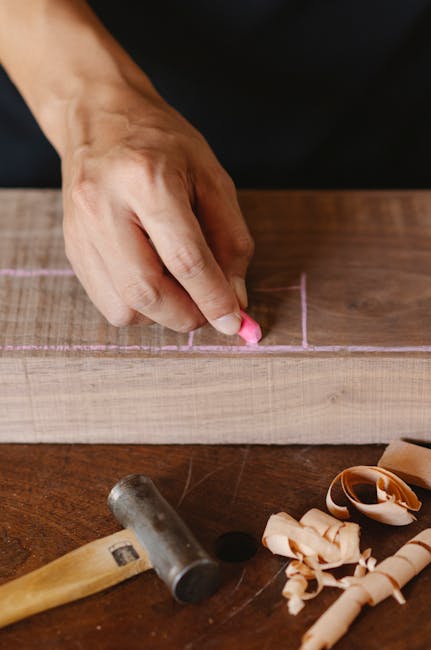There was definitely some mixed opinions about
my choice of hammer or mallet, and still to this day I'm getting emails. I think some get it but a lot of people are
very opposed to it, basically I'm going to definitely destroy my chisels with it. There's a bit of a story really with why I
use it. I used to use a wooden mallet, that's what I was trained to use, that's what I've
always used. I liked a round headed mallet, I found it
quite fast. I was battering through a job one day and it did that thing where you're
going like this, and you look and you've just got the handle
left, and there's that delayed thud, behind you where the head's flew off. And I definitely wasn't gonna, or in the mood
to make a mallet to replace it So I looked over, and doing that thing where
you're hoping that the solution will just present itself and it did There was my lump hammer. It was originally
for on my forge. Because I like to do forging as a hobby, or I did at the time.
This isn't
the original handle, this is just a branch that I stuck in it because the handle then
snapped. But, I've been using this for years and I've never broke a chisel handle with
it, I've broke chisel handles in the past. It's a perfectly normal problem to have, but
I've never broke a chisel handle yet with this. I'm not saying it's never gonna do it,
it will do I'm sure. I've got a few chisels here that I use daily with it.
You can see
the heads, there's absolutely no damage what so ever. There's no cracking, absolutely nothing.
These are the old Marple's split proofs, these are classics these. I h=got these when I finished
my apprenticeship, my old man bought me them. And I've used them every day since. Of course
you wouldn't expect these to split, these are made to be used with a bloody claw hammer.
There's one here with a metal hoop on it, it's slightly burred, but there's nothing
I'd worry about.
These get thumped every single day. There's another one there, another butt
chisel, no problems there. These are my most used chisels throughout the day. I've really
never had any trouble, and I think the thing is, I think you sort of assume that you're
just gonna go full welly on a chisel with your mallet. With a metal hammer that's not
the case. What you tend to find is that the metal isn't going to absorb like a wooden,
it's not going to absorb it's energy like a wooden mallet does.
With a wooden mallet
you've really got to thump it. With this you've only got to tap it and all of it's energy
is transferred to the chisels edge and I think that's obviously a good, a key part of it.
Now I would expect to get death threats if I was using a claw hammer, something like
this, now this is where our perception perhaps of using a metal hammer is bad practice.
So
what is the difference? There both steel. Why isn't that splitting my handle but that
most definitely would? And it's as simple as this has a small face, and you're only
gonna run in to trouble when you just, you know, scim your blow off it, so you're coming
down and you just clump it to one side. And it's doing that repetitively, that's what's
gonna shag your chisel handle. Something like this, this great big face on it. I'm hardly
gonna miss, and even if I did I recon it's to do with that rounded face, it's slightly
curved.
So there's no, there's minimal chance of missing your blow as such, and that's what's
gonna damage it. Now I am a very weak minded individual, and I have bent to peer pressure.
And somebody recommended that I tried this out, this is, it's made in England. It's called
the Thor. I always thought that was me Thor, but this is the Thor.
And it's, I don't know
what it's intention is, I suppose it's just a general purpose mallet. I don't know if
it was intended for chisel purposes, but I did, I bought one. And I will, I have to admit
this is the best mallet I've ever used, I don't use this anymore. Since coming to this
I've barely picked that up. I've been staggered by it, and whoever it was that recommended
it, I do owe you a pint, because its, it's phenomenal. I would never have expected it,
the soft face is brilliant. You can get them with two hard plastic ones, or one with soft.
I took a punt on the soft face one, and that's brilliant for assembling.
It's the only mallet
you need. And this, this seems to transfer energy much more like a metal hammer, which
is good. Once you've used stuff like this you won't go back to a wooden mallet again,
there just seems so much more work involved in using them. This, it's just so light and
it does transfer well. It's funny really because when you look around, well I call us Western
woodworkers, but if you look in the East and all of that and they all use metal hammers
without much trouble. And even a lot of fine woodworkers today, you see them and they have
these little snazzy, brass mallets and they're like almost holding them in their palm, they're
tiny little handles on them.

We don't have a problem with that, and I know it's brass,
I know it's a little softer than this iron, but it's, it's still a lot harder than the
wood, and that doesn't risk breaking the handle. And again it all comes down to having a nice
wide face. I'm not going to recommend you go get yourself a lump hammer and start clumping
your chisels. If you're happy with what you've got use it, if you're looking at buying a
mallet get one of them.
That is brilliant. But no, if I do ever use that, send me death
threats. But leave Lumpy alone. Another question that's led off this, is do
I get one arm bigger than the other using it? The answer is no, I don't think. Because,
like I've said, I'm not wellying it, if I was wellying it I can imagine, but I don't
know, let me see if I can find a bit of wood. There's a bit there, it's a bit of pine. You
can see with a metal hammer how very light I'm being, and yet you can see it sinks in.
I mean, look at that, that's gone right in, that's the second bash. You know, we're a
quarter inch in there. If I go again, you can see I'm not having to hit this thing hard,
I'm just letting it drop. I know from experience that using a wooden mallet, unless it's oil
filled or you've filled it with a weight, a lot of mallets have weights added.
You know,
you've got to give it a bit more of a swing, or use a bigger mallet. This, again back on
this. Sorry, I love this thing. It, it hits like the metal hammer. You know, look at that,
bloody hell. It just slides in. So, no I don't get a bigger arm than the other but that's
because I'm not giving it any welly. And whilst we're on the subject of metal hammers.
I also, because I'm sure this is going to come up in a future videos when you see me
doing it. I adjust metal planes with them as well. And I read quite a lot, I think it's
even in older books, you know you shouldn't maybe perhaps use a metal hammer.
But, I again
I've never had trouble. And I think the key to that, you know, I tap the blade, no problem,
and it does it burrs over a little bit, they all have, all these planes you know, you can
tell you've hit it with a metal hammer. But there's just so much more feed back with iron,
than there is with wood. And as regards to the wedge, you don't damage it if it fits
well, because you're not having to hit it hard, you only have to tap it, and that's
the key. It really is. Another final note that is definitely worth
mentioning, is obviously technique. And I always remember seeing when I did some site
work, a plumber and he was battering out this chock of wood that he needed to get some pipes
past. And he had a wooden handled chisel and of course using the claw hammer, and he basically
just stuck it in this frame. And he was wellying the thing. And urghh, I felt ill watching
it.
And that's a lot of the trouble you see, you've got to understand that a chisel no
matter how sharp is a wedge. And it's always only going to go so far and then it's just
going to bottom out. It's going to wedge itself in and it doesn't matter if that's sharp,
that edge is sharp enough to split an atom, it ain't going to go no further, because you've
still got width of the chisel to contend with.
Thickness of the blade. So it's always making
sure that you make relief cuts, and that's even that goes with a wooden mallet anything.
A wooden mallet you'll smash the mallet head or the chisel if you just. Lets sink one in
a do the example. I'll use that so no one's ill. So that, that is one clump. That is as
hard as I would ever need to hit a chisel. If I wanted to go deeper, because, lets say
I was relieving some waste. Lets say we're cutting a mortice, we're cutting a mortice
here, and I want to go right the way through. If I wanted to go any deeper than that, in
a poor woodworker's mind, you would come along and just clump it again, you know you'd be
banging that like billio, and wondering why you're not getting no deeper. And that's because,
it's done it's wedge thing, it's maxed out. Different species of timber are gonna have
a different limit to that on the compression blah de blah de blah, but what I do now, if
I want to go deeper, is obviously just come out, put it in front of the cut, make a relief,
get rid of that waste.
Go a bit further. And you can see already, I'm going so deep already.
You know, I'm approaching half inch now. You know it's, that's the key. You've got to relieve
waste you can't hit, even a tree you can't hit it with an axe and keep hitting that same
spot. You've got to take that waste out, to give the chisel room to go in.
A chisel never
needs to be struck heavily, if you are, the technique is poor and you need to revaluate
why your waste is clogging the chisel. You should only have to tap.
Now I'm not too bothered about YouTube likes, but I am currently a little bit addicted to
Facebook. So a like on there would be appreciated..

